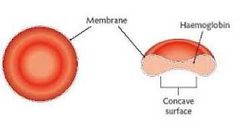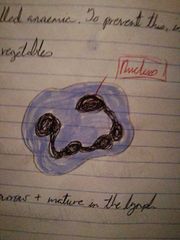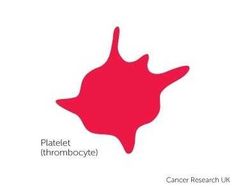![]()
![]()
![]()
Use LEFT and RIGHT arrow keys to navigate between flashcards;
Use UP and DOWN arrow keys to flip the card;
H to show hint;
A reads text to speech;
30 Cards in this Set
- Front
- Back
|
What type of tissue is blood? |
Vascular |
|
|
pH of blood |
7.4 (alkaline) |
|
|
Composition of Blood |
55% Plasma 45% Blood Cells: Red blood cells, white blood cells, platelets |
|
|
Composition of Plasma |
Liquid made up of 90% water + 10% dissolved substances |
|
|
Water's purpose in Plasma |
Transport blood cells + dissolved substances |
|
|
Types of dissolved substances in plasma and give examples |
- Nutrients: glucose, amino acids, fatty acids, glycerol - Wastes: carbon dioxide, urea - Hormones: insulin, testosterone - Gases: carbon dioxide, oxygen - Salts - Large Proteins: albumen, fibrinogen |
|
|
What is Albumen? |
Protein that makes blood thicker |
|
|
What is Fibrinogen? |
Protein which helps blood clot |
|
|
Structure of Red Blood Cells |

- Biconcave discs with large surface area to increase transport of oxygen - No nucleus (more haemoglobin fit in) + flexible membrane to fit through small capillaries - No mitochondria - Contain protein pigment haemoglobin. Haemoglobin binds with oxygen to form oxyhaemoglobin so oxygen can be transported to the body's cells. - Cytoplasm with large amount of haemoglobin |
|
|
Lifecycle of Red Blood Cells |
- Formed in red bone marrow of bone (ribs, sternum, vertebrae) - Live for 120 days then broken down by liver + spleen |
|
|
Function of Red Blood Cells |
- Transport oxygen around the body in the form of oxyhaemoglobin - Transport carbon dioxide from blood to lungs to be removed |
|
|
Cause and Prevention of Anaemia |
Lack of iron in diet. Iron rich foods for prevention. E. G. Red meat, green leafy veg |
|
|
Structure of White Blood Cells |

- Larger than RBCs - Contain a nucleus - Don't contain haemoglobin |
|
|
Lifecycle of White Blood Cells |
Formed in red bone marrow + mature in lymph system |
|
|
Function of White Blood Cells |
Protect body against disease |
|
|
Types of White Blood Cells |

Lymphocytes and Monocytes (Phagocytes) |
|
|
Lymphocytes: Life Cycle, Structure and Function |

Life Cycle: Made in red bone marrow, mature in lymph system Structure: Large nucleus, no granules in cytoplasm Function: Produce proteins called antibodies which are chemicals that kill bacteria + viruses |
|
|
Monocytes (Phagocytes): Lifecycle, Structure and Function |

Life Cycle: Made and mature in red bone marrow Structure: Large lobed nucleus, granules on cytoplasm Function: Engulf bacteria by phagocytosis |
|
|
Structure of Platelets |

Tiny fragments of cells made in red bone marrow with no nucleus |
|
|
Where are platelets made? |
Made in red bone marrow |
|
|
Function of platelets |
Blood clotting of skin's surface + damaged blood vessels |
|
|
Functions of Blood |
Transport, Protection and Temperature Regulation |
|
|
Substances Transported by Blood |
- Oxygen carried as oxyhaemoglobin from lungs to cells in RBCs - Carbon Dioxide carried from cells to lungs in RBCs + as ions in plasma - Digested nutrients (e.g. Glucose) carried from digestive system to cells - Wastes carried from cells to skin, lungs + kidneys to be removed e.g. Urea, CO2 - Hormones produced by glands + carried around the body e.g. Insulin |
|
|
Protection by Blood |
Monocytes: Destroy bacteria by phagocytosis Lymphocytes: Destroy bacteria by producing antibodies Platelets: Blood clotting |
|
|
Temperature Regulation in Blood |
- Blood circulating carries heat around body to keep temperature constant - Blood brings water + salts to sweat glands to be removed |
|
|
What does blood type depend on? |
Glycoprotein (antigen made of carbohydrate + protein) that is on surface of RBCs |
|
|
Types of Blood Groups |
A: RBCs have A antigens B: RBCs have B antigens AB: RBCs have A and B antigens O: RBCs do not have antigens |
|
|
Why are blood groups essential for blood transfusions? |
Body will make antibodies to destroy foreign antigens |
|
|
What is the Rhesus Factor? |
Another way to group blood groups depending on whether or not individuals have an antigen called "factor D". Have factor D = Rhesus positive (Rh+). No factor D = Rhesus negative (Rh-) |
|
|
Why is Rhesus factor important during pregnancy? |
Rh+ and Rh- shouldn't mix which can occur if mother and baby have different blood types. If Rh- mothers have Rh+ child, mothers' antibodies will fight against the foetus' RBCs which can cause anaemia or miscarriage. |

